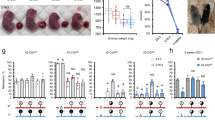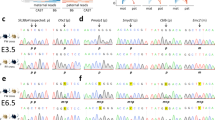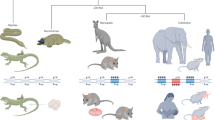Key Points
-
Genomic imprinting describes a form of non-Mendelian gene expression, in which the expression of an allele depends on its parent of origin. In most cases, one allele (either the one inherited from mother or the one inherited from father) is expressed and the other is transcriptionally inactive, although more complex patterns are also observed.
-
So far, more than 60 imprinted genes have been identified in mice. In most cases, these genes are also imprinted in humans.
-
Among the vertebrates, imprinting seems to be restricted to the marsupials and the placental mammals.
-
Many imprinted genes influence fetal growth, although some affect behavioural phenotypes that persist into adulthood.
-
The most commonly accepted explanation for the prevalence of diploidy is that it shields the individual from the effects of recessive deleterious mutations. Monoallelic expression exposes these mutations to selection, resulting in a 'cost of imprinting'. Therefore, there must be selective forces that overcome these costs at imprinted loci.
-
This review discusses three theories that attempt to explain the selective advantage of genomic imprinting: 'evolvability' models propose that imprinting enhances the adaptive evolution of a species in the face of a changing environment; the ovarian timebomb hypothesis proposes that imprinting protects female mammals from the ravages of trophoblastic disease; and the kinship theory proposes that imprinting arises as a result of an evolutionary conflict in organisms between genes of maternal and paternal origin.
-
Although the kinship theory has been the most successful theory in explaining the observed patterns of imprinting, it is still unclear whether it can account for all instances of imprinting. This determination will have to await a more detailed understanding of the phenotypic effects of imprinted genes.
Abstract
Parent-specific gene expression (genomic imprinting) is an evolutionary puzzle because it forgoes an important advantage of diploidy — protection against the effects of deleterious recessive mutations. Three hypotheses claim to have found a countervailing selective advantage of parent-specific expression. Imprinting is proposed to have evolved because it enhances evolvability in a changing environment, protects females against the ravages of invasive trophoblast, or because natural selection acts differently on genes of maternal and paternal origin in interactions among kin. The last hypothesis has received the most extensive theoretical development and seems the best supported by the properties of known imprinted genes. However, the hypothesis is yet to provide a compelling explanation for many examples of imprinting.
This is a preview of subscription content, access via your institution
Access options
Subscribe to this journal
Receive 12 print issues and online access
$189.00 per year
only $15.75 per issue
Buy this article
- Purchase on Springer Link
- Instant access to full article PDF
Prices may be subject to local taxes which are calculated during checkout
Similar content being viewed by others
References
Stern, C. The nucleus and somatic cell variation. J. Cell. Comp. Physiol. 52 (Suppl.), 1–34 (1958).
Crouse, H. V. The controlling element in sex chromosome behavior in Sciara. Genetics 45, 1429–1443 (1960).
Hayward, B. E., Moran, V., Strain, L. & Bonthron, D. T. Bidirectional imprinting of a single gene: GNAS1 encodes maternally, paternally, and biallelically derived proteins. Proc. Natl Acad. Sci. USA 95, 15475–15480 (1998).
Otto, S. P. & Goldstein, D. B. Recombination and the evolution of diploidy. Genetics 131, 745–751 (1992).
McGowan, R. & Martin, C. C. DNA methylation and genome imprinting in the zebrafish, Danio rerio: some evolutionary ramifications. Biochem. Cell Biol. 75, 499–506 (1997).
Beaudet, A. L. & Jiang, Y. A rheostat model for a rapid and reversible form of imprinting-dependent evolution. Am. J. Hum. Genet. 70, 1389–1397 (2002). The proposal that genomic imprinting enhances the evolvability of a population.
Varmuza, S. & Mann, M. Genomic imprinting — defusing the ovarian time bomb. Trends Genet. 10, 118–123 (1994). The proposal that genomic imprinting evolved to protect female mammals from the ravages of trophoblastic disease.
Haig, D. Genomic Imprinting and Kinship (Rutgers Univ. Press, New Brunswick, 2002). A collection of papers that trace the development of the kinship theory, with retrospective commentaries.
Haig, D. & Trivers, R. in Genomic Imprinting: Causes and Consequences (eds Ohlsson, R., Hall, K. & Ritzen, M.) 17–28 (Cambridge Univ. Press, Cambridge, UK, 1995).
Hurst, L. D. in Genomic Imprinting (eds Reik, W. & Surani, A.) 211–237 (Oxford Univ. Press, Oxford, UK, 1997).
Iwasa, Y. & Pomiankowski, A. Sex specific X chromosome expression caused by genomic imprinting. J. Theor. Biol. 197, 487–495 (1999).
Pardo-Manuel de Villena, F., de la Casa-Esperón, E. & Sapienza, C. Natural selection and the function of genome imprinting: beyond the silenced minority. Trends Genet. 16, 573–579 (2000).
Ohlsson, R., Paldi, A. & Graves, J. A. M. Did genomic imprinting and X chromosome inactivation arise from stochastic expression? Trends Genet. 17, 136–141 (2001).
Sleutels, F. & Barlow, D. P. The origins of genomic imprinting in mammals. Adv. Genet. 46, 119–163 (2002).
Reik, W. & Walter, J. Genomic imprinting: parental influence on the genome. Nature Rev. Genet. 2, 21–32 (2001).
Tycko, B. & Morison, I. M. Physiological functions of imprinted genes. J. Cell. Physiol. 192, 245–258 (2002).
Spencer, H. G. Mutation-selection balance under genomic imprinting at an autosomal locus. Genetics 147, 281–287 (1997).
Iwasa, Y., Mochizuki, A. & Takeda, Y. The evolution of genomic imprinting: abortion and overshoot explain aberrations. Evol. Ecol. Res. 1, 129–150 (1999).
Greenwood-Lee, J. M., Taylor, P. D. & Haig, D. The inclusive fitness dynamics of genomic imprinting. Selection 2, 101–116 (2001).
Weisstein, A. E., Feldman, M. W. & Spencer, H. G. Evolutionary genetic models of the ovarian time bomb hypothesis for the evolution of genomic imprinting. Genetics 162, 425–439 (2002).
O'Neill, M. J., Ingram, R. S., Vrana, P. B. & Tilghman, S. M. Allelic expression of IGF2 in marsupials and birds. Dev. Genes Evol. 210, 18–20 (2000). This paper shows that IGF2 is imprinted in an opossum but not in chickens.
Killian, J. K. et al. Divergent evolution in M6P/IGF2R imprinting from the Jurassic to the Quaternary. Hum. Mol. Genet. 10, 1721–1728 (2001).
Mossman, H. W. Vertebrate Fetal Membranes (Rutgers Univ. Press, New Brunswick, New Jersey, 1987).
Feil, R., Khosla, S., Cappai, P. & Loi, P. Genomic imprinting in ruminants: allele-specific gene expression in parthenogenetic sheep. Mamm. Genome 9, 831–834 (1998).
Haig, D. Placental hormones, genomic imprinting, and maternal-fetal communication. J. Evol. Biol. 9, 357–380 (1996).
Hamilton, W. D. The genetical evolution of social behaviour. J. Theor. Biol. 7, 1–52 (1964).
Haig, D. Parental antagonism, relatedness asymmetries, and genomic imprinting. Proc. R. Soc. Lond. B 264, 1657–1662 (1997). A paper that generalizes the kinship theory to all interactions among kin.
Trivers, R. & Burt, A. in Genomic Imprinting: An Interdisciplinary Approach (ed. Ohlsson, R.) 1–21 (Springer, Berlin, 1999).
Haig, D. The kinship theory of genomic imprinting. Ann. Rev. Ecol. Syst. 31, 9–32 (2000).
Burt, A. & Trivers, R. Genetic conflicts in genomic imprinting. Proc. R. Soc. Lond. B 265, 2393–2397 (1998). A paper that discusses the possible conflicts between imprinted genes and the genes that are responsible for the establishment of imprints in parental germlines.
Lessells, C. M. & Parker, G. A. Parent-offspring conflict: the full-sib-half-sib fallacy. Proc. R. Soc. Lond. B 266, 1637–1643 (1999).
Haig, D. Genomic imprinting, sex-biased dispersal, and social behaviour. Ann. NY Acad. Sci. 907, 149–163 (2000).
Haig, D. Asymmetric relations: internal conflicts and the horror of incest. Evol. Hum. Behav. 20, 83–98 (1999).
Wilkins, J. F. & Haig, D. Inbreeding, maternal care and genomic imprinting. J. Theor. Biol. 221, 559–564 (2003).
Haig, D. & Wilkins, J. F. Genomic imprinting, sibling solidarity and the logic of collective action. Phil. Trans. R. Soc. Lond. B 355, 1593–1597 (2000).
Mochizuki, A., Takeda, Y. & Iwasa, Y. The evolution of genomic imprinting. Genetics 144, 1283–1295 (1996).
Iwasa, Y., Mochizuki, A. & Takeda, Y. The evolution of genomic imprinting: abortion and overshoot explain aberrations. Evol. Ecol. Res. 1, 129–150 (1999).
Kondoh, M. & Higashi, M. Reproductive isolation mechanism resulting from resolution of intragenomic conflict. Am. Nat. 156, 511–518 (2000).
Wilkins, J. F. & Haig, D. Genomic imprinting at two antagonistic loci. Proc. R. Soc. Lond. B 268, 1861–1867 (2001).
Killian, J. K. et al. M6P/IGF2R imprinting evolution in mammals. Mol. Cell 5, 707–716 (2000). This paper shows that M6P/IGF2R is not imprinted in monotremes and lacks an IGF2 binding site. The binding site is present in marsupials and the gene is imprinted.
Killian, J. K. et al. Monotreme IGF2 expression and ancestral origin of genomic imprinting. J. Exp. Zool. 291, 205–212 (2001).
Spencer, H. G. & Williams, M. J. M. The evolution of imprinting: two modifier-locus models. Theor. Pop. Biol. 51, 23–35 (1997).
Wilkins, J. F. & Haig, D. Parental modifiers, antisense transcripts and loss of imprinting. Proc. R. Soc. Lond. B 269, 1841–1846 (2002). A theoretical paper, which predicts that imprints that are established in paternal germlines will be evolutionarily less stable than imprints that are established in maternal germlines.
Reik, W. & Walter, J. Evolution of imprinting mechanisms: the battle of the sexes begins in the zygote. Nature Genet. 27, 255–256 (2001). Most methylation imprints are established in maternal germlines. Many padumnally silent genes are inactivated indirectly by the methylation of maternal antisense promoters.
Spencer, H. G., Feldman, M. W. & Clark A. G. Genetic conflicts, multiple paternity and the evolution of genomic imprinting. Genetics 148, 893–904 (1998).
Spencer, H. G. Population genetics and the evolution of genomic imprinting. Ann. Rev. Genet. 34, 457–477 (2000). A review of the formal population genetic models of genomic imprinting.
Eshel, I. On the changing concept of evolutionary population stability as a reflection of a changing point of view in the quantitative theory of evolution. J. Math. Biol. 34, 485–510 (1996).
Haig, D. Multiple paternity and genomic imprinting. Genetics 151, 1229–1231 (1999).
Hurst, L. D. & McVean, G. T. Growth effects of uniparental disomies and the conflict theory of genomic imprinting. Trends Genet. 13, 436–443 (1997).
Dawson, W. D. Fertility and size inheritance in a Peromyscus species cross. Evolution 19, 44–55 (1965).
Vrana, P. B., Guan, X. -J., Ingram, R. S. & Tilghman, S. M. Genomic imprinting is disrupted in interspecific Peromyscus hybrids. Nature Genet. 20, 362–365 (1998). A paper showing that imprinting can contribute to reproductive isolation between species.
Vrana, P. B. et al. Genetic and epigenetic incompatibilities underlie hybrid dysgenesis in Peromyscus. Nature Genet. 25, 120–124 (2000).
Hurst, L. D. Peromysci, promiscuity and imprinting. Nature Genet. 20, 315–316 (1998).
Hurst, L. D. & McVean, G. T. Do we understand the evolution of genomic imprinting? Curr. Opin. Genet. Dev. 8, 701–708 (1998).
Haig, D. Genetic conflicts and the private life of Peromyscus polionotus. Nature Genet. 22, 131 (1999).
Foltz, D. W. Genetic evidence for long-term monogamy in a small rodent, Peromyscus polionotus. Am. Nat. 117, 665–675 (1981).
Moore, T. & Mills, W. Imprinting and monogamy. Nature Genet. 22, 130–131 (1999).
Lefebvre, L. et al. Abnormal maternal behaviour and growth retardation associated with loss of the imprinted gene Mest. Nature Genet. 20, 163–169 (1998).
Li, L. -L. et al. Regulation of maternal behavior and offspring growth by paternally expressed Peg3. Science 284, 330–333 (1999).
Smits, G., Parma, J. & Vassart, G. Peg3 and the conflict hypothesis. Science 287, 1167 (2000).
Hurst, L. D., Pomiankowski, A. & McVean, G. Peg3 and the conflict hypothesis. Science 287, 1167 (2000).
Haig, D. & Westoby, M. Parent-specific gene expression and the triploid endosperm. Am. Nat. 134, 147–155 (1989). The first published version of the kinship theory.
Haig, D. & Westoby, M. Genomic imprinting in endosperm: its effects on seed development in crosses between species and between different ploidies of the same species, and its implications for the evolution of apomixis. Phil. Trans R. Soc. Lond. B 333, 1–13 (1991).
Grossniklaus, U., Vielle-Calzada, J. -P., Hoeppner, M. A. & Gagliano, W. B. Maternal control of embryogenesis by MEDEA, a Polycomb group gene in Arabidopsis. Science 280, 446–450 (1998). The first imprinted gene that was identified in Arabidopsis.
DeChiara, T. M., Robertson, E. J. & Efstratiadis, A. Parental imprinting of the mouse insulin-like growth factor II gene. Cell 64, 849–859 (1991).
Barlow, D. P., Stöger, R., Herrmann, B. G., Saito, K. & Schweifer, N. The mouse insulin-like growth factor type-2 receptor is imprinted and closely linked to the Tme locus. Nature 349, 84–87 (1991).
Ludwig, T. et al. Mouse mutants lacking the type 2 IGF receptor (IGF2R) are rescued from perinatal lethality in Igf2 and Igf1r null backgrounds. Dev. Biol. 177, 517–535 (1996).
Haig, D. & Graham, C. Genomic imprinting and the strange case of the insulin-like growth factor-II receptor. Cell 64, 1045–1046 (1991).
Kornfeld, S. Structure and function of the mannose 6-phosphate/insulinlike growth factor II receptors. Annu. Rev. Biochem. 61, 307–330 (1992).
Dahms, N. M. & Hancock, M. K. P-type lectins. Biochim. Biophys. Acta 1572, 317–340 (2002).
Dahms, N. M., Brzycki-Wessell, M. A., Ramanujam, K. S. & Seethram, B. Characterization of mannose 6-phosphate receptors (MPRs) from opossum liver: opossum cation-independent MPR binds insulin-like growth factor-II. Endocrinology 133, 440–446 (1993).
Yandell, C. A., Dunbar, A. J., Wheldrake, J. F. & Upton, Z. The kangaroo cation-independent mannose 6-phosphate receptor binds insulin-like growth factor II with low affinity. J. Biol. Chem. 274, 27076–27082 (1999).
Clairmont, K. B. & Czech, M. P. Chicken and Xenopus mannose 6-phosphate receptors fail to bind insulin-like growth factor II. J. Biol. Chem. 264, 16390–16392 (1989).
Nolan, C. M., Killian, J. K., Pettite, J. N. & Jirtle, R. L. Imprint status of M6P/IGF2R and IGF2 in chickens. Dev. Genes Evol. 211, 179–183 (2001).
Hughes, R. L. & Hall, L. S. Early development and embryology of the platypus. Phil. Trans. R. Soc. Lond. B 353, 1101–1114 (1998).
Grant, T. R. & Temple-Smith, P. D. Field biology of the platypus (Ornithorhynchus anatinus): historical and current perspectives. Phil. Trans. R. Soc. Lond. B 353, 1081–1091 (1998).
Constância, M. et al. Placental-specific IGF-II is a major modulator of placental and fetal growth. Nature 417, 945–948 (2002).
Sleutels, F., Zwart, R. & Barlow, D. P. The non-coding Air RNA is required for silencing autosomal imprinted genes. Nature 415, 810–813 (2002).
Gimenez-Roqueplo, A. -P. et al. The R22X mutation of the SDHD gene in hereditary paraganglioma abolishes the enzymatic activity of complex II in the mitochondrial respiratory chain and activates the hypoxia pathway. Am. J. Hum. Genet. 69, 1186–1197 (2001).
Cavaillé, J. et al. Identification of brain-specific and imprinted small nucleolar RNA genes exhibiting an unusual genomic organization. Proc. Natl Acad. Sci. USA 97, 14311–14316 (2000).
Lau, M. M. H. et al. Loss of the imprinted IGF2/cation-independent mannose 6-phosphate receptor results in fetal overgrowth and perinatal lethality. Genes Dev. 8, 2953–2963 (1994).
Tanaka, M., Gertsenstein, M., Rossant, J. & Nagy, A. Mash2 acts cell autonomously in mouse spongiotrophoblast development. Dev. Biol. 190, 55–65 (1997).
Yu, S. et al. Variable and tissue-specific hormone resistance in heterotrimeric Gs protein α-subunit (Gsα) knockout mice is due to tissue-specific imprinting of the Gsα gene. Proc. Natl Acad. Sci. USA 95, 8715–8720 (1998).
Sado, T., Wang, Z., Sasaki, H. & Li, E. Regulation of imprinted X-chromosome inactivation in mice by Tsix. Development 128, 1275–1286 (2001).
Fang, P. et al. The spectrum of mutations in UBE3A causing Angelman syndrome. Hum. Mol. Genet. 8, 129–135 (1999).
Acknowledgements
The authors thank C. Muirhead, R. Trivers and the anonymous reviewers for helpful comments on the manuscript.
Author information
Authors and Affiliations
Corresponding author
Related links
Related links
DATABASES
LocusLink
OMIM
FURTHER INFORMATION
Glossary
- EPIGENETIC
-
Modifications of chromatin or DNA (for example, histone deacetylation and cytosine methylation) that can be stably transmitted through many cell divisions, but can also be reset (unlike the DNA sequence).
- EVOLVABILITY
-
The capacity of a genetic system to generate new adaptations.
- FUNCTION
-
The phenotypic effects of a DNA sequence that are responsible for the selective maintenance of its integrity in the face of mutational processes.
- UNIPARENTAL DISOMIES
-
Both copies of a chromosome derived from one parent.
- TERATOMA
-
A tumour consisting of several cell types.
- TROPHOBLAST
-
The extraembryonic cell population at the maternal–fetal interface. In mice and humans, elements of the trophoblast invade the maternal tissues of the uterus.
- CHORIOVITELLINE
-
A placenta that is derived from the fusion of the extraembryonic yolk sac and the chorion.
- KIN
-
Individuals that share some of their genes by recent common descent.
- DEMAND INHIBITOR
-
A factor that is produced by an offspring reducing the 'demand' on its mother. That is, the production of the factor decreases the individual fitness of the offspring at a benefit to the expected fitness of its mother from other offspring.
- DEMAND ENHANCER
-
A factor that is produced by an offspring increasing the 'demand' on its mother. That is, the production of the factor increases the individual fitness of the offspring at a cost to the expected fitness of its mother from other offspring.
Rights and permissions
About this article
Cite this article
Wilkins, J., Haig, D. What good is genomic imprinting: the function of parent-specific gene expression. Nat Rev Genet 4, 359–368 (2003). https://doi.org/10.1038/nrg1062
Issue Date:
DOI: https://doi.org/10.1038/nrg1062
This article is cited by
-
Conservation and divergence of canonical and non-canonical imprinting in murids
Genome Biology (2023)
-
The contribution of imprinted genes to neurodevelopmental and neuropsychiatric disorders
Translational Psychiatry (2022)
-
Conflict and the evolution of viviparity in vertebrates
Behavioral Ecology and Sociobiology (2022)
-
Genetic conflicts and the case for licensed anthropomorphizing
Behavioral Ecology and Sociobiology (2022)
-
The neural mechanisms and consequences of paternal caregiving
Nature Reviews Neuroscience (2019)



